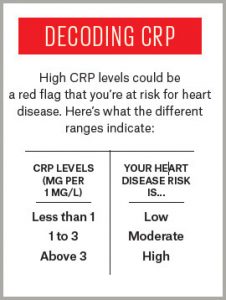INFLAMMATION INCREASES OUR RISK FOR MANY HEALTH PROBLEMS, AND AFFECTS HOW WE AGE.
CAN WE QUELL THIS KILLER?
BY CATHERINE WINTERS
Who hasn’t been affected by inflammation? The skinned knee that turns red. The ankle that balloons upon suffering a sprain. The nasty case of bronchitis that seems to last forever. The pimple that erupts on your chin the day of your important job interview.
These episodes may not be fun to endure, but this type of inflammation is actually a good thing. “It’s one of the most important aspects of our body’s ability to heal,” says Tieraona Low Dog, MD, of the Arizona Center for Integrative Medicine in Tucson. According to the doctor, acute inflammation (quick, with symptoms that are typically present for just a few days), occurs when the immune system senses an outside invader and mounts a two-pronged attack. Extra blood travels to the injured area to help with healing while white blood cells leap into action to fight off infection.
Like Dr. Jekyll, however, inflammation has a dark side. That alter ego comes in the form of chronic, low-grade inflammation. Research shows that this second type of inflammation is associated with many health problems, including cardiovascular disease, gum disease, eczema, osteoporosis, dry eye, various cancers, type 2 diabetes, Alzheimer’s disease, and osteoarthritis. Even obesity is a disease of inflammation. “Visceral fat in the abdomen generates a lot of free fatty acids, which trigger an inflammatory response,” says Robert M. Carey, MD, of UVA’s School of Medicine. Carey is a former president of the Endocrine Society.
Such simmering inflammation also drives many autoimmune diseases such as rheumatoid arthritis, Graves disease, lupus, and celiac disease. In these instances, the body mounts an inflammatory response against itself.
The Roots of Inflammation
Acute inflammation is caused by germs (such as a virus or bacteria), an injury, or an environmental trigger. Meanwhile, chronic inflammation can come from the foods we eat and the water we drink, a sedentary lifestyle, or exposure to toxins. “The modern lifestyle has led many to have chronic inflammation in the body,” says Dr. Low Dog.


One major dietary culprit is an imbalance of omega-6 and omega-3 fatty acids. Omega-6 fatty acids found in vegetable oils (corn, soy, safflower, cottonseed, and sunflower) and in livestock trigger inflammation. Omega-3 fatty acids (fish, marine oil, walnuts, and flax seed) fight inflammation.
The ideal ratio of omega-6s to omega-3s is 1 to 1—a balance that keeps the risk of chronic inflammation from developing. However, modern-day food processing has caused our diet to become jam-packed with omega-6 fatty acids. Our ratio of omega-6s to 3s is oftentimes as high as 20 to 1. That’s a surefire recipe for inflammation, and an invitation for a host of health repercussions.
One study found that people who ingest the highest amounts of vegetable fat have more than a two-fold increased risk for advanced age-related macular degeneration—the leading cause of blindness in older adults. Another study, published in The Journal of Clinical Oncology, reported that breast-cancer survivors who get higher levels of omega-3s compared to omega-6s have less inflammation and fatigue. People who suffer from, or who are at risk for, metabolic syndrome (a cluster of inflammatory conditions that raise heart disease risk), may lower levels of inflammation by eating a diet rich in omega-3s, according to one review. The list goes on.
READ MORE: 10 TACTICS TO TAME INFLAMMATION
All of us are fair game for health problems caused by undetected inflammation. Atherosclerosis, or hardening of the arteries, is caused by low-grade inflammation. So are many cancers. “Chronic inflammation at a site in the body can lead to cancer in that area,” says Dr. William J. Meggs, chief of toxicology at East Carolina University’s Brody School of Medicine in Greenville, North Carolina.
Persistent inflammation can worsen a pre-existing condition, or trigger inflammation in another area of the body. Such is the case when a person with asthma gets the flu. “Inflammatory cells fighting the flu excite inflammatory cells in the lungs of the patient with asthma,” explains Dr. Meggs.
“Similarly, people with rheumatoid arthritis are more susceptible to blockages in heart arteries than those without RA.”
For people with a genetic predisposition for a particular disease, inflammation can increase the odds of developing it. “The interplay between environment, lifestyle, and genes determines exactly who gets what disease and at what time in their life,” Dr. Meggs says.
Chronic inflammation may also cause seemingly unrelated problems. One group of researchers has found that women with inflammatory conditions—psoriasis, rheumatoid arthritis, inflammatory bowel disease, or lupus—have a two-to– five-fold increased risk of entering menopause before age 45 and for premature ovarian failure.
Despite these effects on health, doctors don’t routinely screen patients for inflammation. Yet knowing if it’s present in our body makes good preventive health sense, say experts in functional, preventive, and anti-aging medicine. “My goal is to find disease before it happens,” says Amy Myers, MD. Myers is the medical director of Austin UltraHealth in Texas, specializing in functional medicine.


Dr. Myers routinely conducts a comprehensive blood panel on new patients, measuring levels of an inflammatory marker called C-Reactive Protein, or CRP. Levels climb when there’s inflammation in the body. Even if a patient has normal levels, Dr. Myers repeats the test annually so she can take preemptive action, should inflammatory markers spike.
There is one catch: The CRP test doesn’t tell you what’s causing inflammation—only that it’s present. CRP levels could be high because you have heart disease, cancer, lupus, or an ingrown toenail. “It might be some little insignificant inflammation going on somewhere,” says Dr. Meggs. Dr. Myers recommends seeing a doctor who specializes in functional, anti-aging, or integrative medicine to measure your CRP levels. Or consider visiting a walk-in lab or using an online lab, such as Directlabs.com, Labtestsonline.com, or Biophysicalcorp.com. Armed with information about your inflammatory levels, you can work with a physician to zero in on the trigger and lower them if they’re high, or take steps to keep them from rising.
Research on the subject of inflammation goes on every day, all the time. The advances made by science are dramatic. Still, there are no guarantees in life. The best anyone can do is be proactive. “The most careful and diligent person still has some risk for disease,” Dr. Meggs notes. While we can’t escape inflammation indefinitely, there are things we can all do to delay its deleterious effects. “We can reduce our risk of getting disease earlier, and live a longer, healthier life.”












